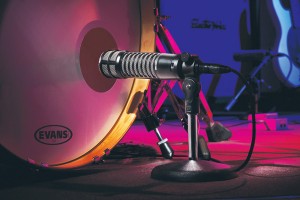
If possible, setting up the drums the night before the session will benefit the efficiency of the session’s start time. This will leave more time to hone in sounds, get the musicians set and make tweaks. Most of the time, having drummers show up 30 minutes earlier than the rest of the band on the day of the session will ensure that there is plenty of time to focus on each drum’s timbre, tuning and finding any sound problems before tracking the reset of the band.
Kick
I like to start at the kick drum and work my way through the kit so the tracks end up in my DAW in an organized fashion. Kick drum heads come in two types: with a sound hole and without. The head that doesn’t have a hole can always be removed and a tunnel can be created with a packing blanket, which will allow access for close miking near the beater that would otherwise be impossible. When using this miking technique, there will be a lot of mic choices, so finding and using one that is suited to the session will be your first decision. Look for a mic that is made specifically for the low frequency range. The next thing to consider will be if a “kick out” mic is going to be used. This would be one that is placed near the outside head of the kick drum to capture more of the boom of the kick and less of the click.
Snare
The snare also has some choices when it comes to miking – will it be a top only mic or top and bottom system during tracking? This mic selection is an extremely important decision and will be the point where you decide to use a dynamic or condenser microphone. An inexpensive and easy answer is to use a Shure SM57. When placing the mic, it will be key to find a spot that doesn’t allow a ton of hi-hat bleed through. The hi-hat is in close proximity to snare drum; if your snare mic is not placed properly, there can be a lot bleed that can’t be removed when it comes time to mix.
Hi-Hats
The hi-hat is usually mixed down due to the amount of bleed that is present from the snare and overhead cymbals, but capturing it is always important. Using a condenser microphone can help capture some of the sizzle.
Toms
When it comes tom miking, usually a top and bottom mic will help reproduce the most natural and full sound. The bottoms will be a little smeared in the bottom end, so EQing the unwanted boom of the bottom mics will help get a nice, tight sound. The top mics will capture some bleed of the cymbals. Try to find a place that uses the mic’s natural cancellation to help get a clean sound while capturing the tom’s natural, resonant tones.
Overheads
There are more choices when it comes to mic placement for overheads. The technique and placement for optimal sound capture is something that has long been debated. This includes where and how to place the mics and if they should be used in conjunction with a ride mic, etc. Many times it’s best if the overhead mics are placed equidistant from each other, and a stereo bar can help make sure that a proper angle is reached with the microphones themselves. This ensures that you’ll capture the whole kit with overheads. When considering mic selection, small diaphragm condensers can give great results. Ribbon microphones can be a great choice as well, if they are available. But phantom power will kill most ribbon mics, so be extremely careful not to send phantom power to them if they are used.
The Room
If the drums are being recorded in a studio, usually recording the room’s natural ambience will help complete the overall tone of the drums, while also capturing the natural characteristics of the recording location. Stereo miking techniques will be best here. So take some time to get familiarized with the different mic options available and stereo miking techniques to ensure the best choice for the room, feel and desired sound.
Sweet Spot
Crucially important, especially with drums, is the finding of the ever-elusive “sweet spot,” including the individual drum mics and room mics. This is a precise technique and usually requires an assistant to help place and move the mic while you monitor the sound and hone in on the best positioning to capture the natural sound of the drum, cymbal, percussive element and room.
Drums can consume a good number of your session’s tracks. A solid understanding of mic techniques and differences will be necessary to ensure they are captured with precision and that the backbone of the rhythm track is strong. Part Two will go inside the control room and look at the some of the common recording techniques and mixing techniques when it comes to recording drums.
Dustin Lefholz is a professional audio engineer. He has certification with a variety of consoles and DAW systems including SSL, Neve, Amek, Trident and Pro Tools. Lefholz has over 170 album credits to his name, including tracking, mixing and mastering.